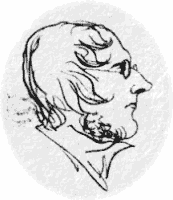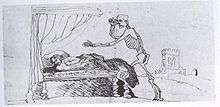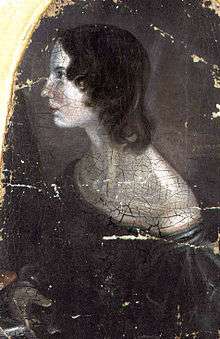Branwell Brontë
Patrick Branwell Brontë (/ˈbrɒnti/, commonly /-teɪ/;[1] 26 June 1817 – 24 September 1848), better known as Branwell Brontë, was an English painter and writer. He was the only son of the Brontë family, and brother of the writers Charlotte, Emily and Anne.
Patrick Branwell Brontë | |
|---|---|
 Branwell Brontë, self-portrait, 1840 | |
| Born | 26 June 1817 Thornton, West Riding of Yorkshire, England |
| Died | 24 September 1848 (aged 31) Haworth, West Riding of Yorkshire, England |
| Nationality | United Kingdom |
| Other names | Branwell Brontë |
| Occupation | painter |
Brontë was rigorously tutored at home by his father, and shared some of his sisters’ creative talent, earning praise for his poetry and translations from the classics. But he drifted between jobs, supporting himself by portrait-painting, and gave way to drug and alcohol addiction, apparently worsened by a failed relationship with a married woman. Brontë died at the age of 31, rather notably insisting on standing till the final moments.
Youth
.jpg)
Branwell Brontë was the fourth of six children and the only son of Patrick Brontë (1777–1861) and his wife, Maria Branwell Brontë (1783–1821).[2][3] He was born in Thornton, near Bradford, West Riding of Yorkshire,[2] and moved with his family to Haworth when his father was appointed to the perpetual curacy in 1821.
While four of his five sisters were sent to Cowan Bridge boarding school, Branwell was educated at home by his father,[2] who gave him a classical education. Elizabeth Gaskell, biographer of his sister, Charlotte Brontë, says of Branwell's schooling "Mr. Brontë's friends advised him to send his son to school; but, remembering both the strength of will of his own youth and his mode of employing it, he believed that Branwell was better at home, and that he himself could teach him well, as he had told others before."[4] His two eldest sisters died just before his eighth birthday in 1825, and their loss affected him deeply.[5]
Even as a young boy Brontë read extensively, and was especially fond of the "Noctes Ambrosianae", literary dialogues published in Blackwood's Magazine.[2] He took leadership role with Charlotte in a series of fantasy role-playing games which the siblings wrote and performed about the "Young Men", characters based on a set of wooden soldiers. The plays evolved into an intricate saga based in West Africa about the fictitious Glasstown confederacy.[2] From 1834, he both collaborated and competed with his sister Charlotte to describe another imaginary world, Angria.[2] Branwell's particular interest in these paracosms were their politics and wars, including the destructive rivalry between their heroes, Charlotte's Arthur Wellesley, Duke of Zamorna, and his Alexander Percy, Earl of Northangerland.[2] These writings impress by their virtuosity and scope, but are also repetitive when compared to Charlotte's contributions.[3] Surrounded by female company and missing that of males, there are signs of pleasure in his early works of the wider options he would have due to his gender.[3] Aged 11 in January 1829 he began producing a magazine, later named Branwell's Blackwood's Magazine which included his poems, plays, criticisms, histories and dialogues.[2] Unlike his sisters, Brontë was not prepared for a specific career.[3] In his only real attempt to find work, on the death of James Hogg, a Blackwood's writer, the 18-year-old Brontë boldly wrote to the magazine suggesting himself as a replacement.[2][3] Between 1835 and 1842, Brontë wrote a total of six times to the magazine, sending poems and arrogantly offering his services.[2][5] His letters were left unanswered.[5] He began enjoying masculine company in the pubs in Haworth, and in February 1836 joined Haworth's Masonic Lodge of the Three Graces at the youngest possible age.[3][6]
In 1829–30, Patrick Brontë engaged John Bradley, an artist from neighbouring Keighley, as drawing-master for the children. Bradley was an artist of some local repute, rather than a professional instructor, but he may well have fostered Branwell's enthusiasm for art and architecture. Bradley emigrated to America in 1831,[7] and Branwell Brontë continued his studies under the portrait painter William Robinson.[2][3] In 1834 he painted a portrait of his three sisters. He included his own image but became dissatisfied with it and painted it out. This portrait is now one of the best known images of the sisters and hangs in the National Portrait Gallery.[2][8]
In 1835, he wrote a letter to the Royal Academy of Arts seeking to be admitted. Earlier biographers reported a move to London to study painting, which quickly ended following Brontë's dissolute spending on drink.[2][9] Other biographers speculated that he was too intimidated to present himself at the Academy. More recent scholarship suggests that Brontë did not send the letter or even make the trip to London.[2] According to Francis Leyland, Brontë's friend and a future biographer of the family, his first job was as an usher at a Halifax school.[3] More certainly, Brontë worked as a portrait painter in Bradford in 1838 and 1839.[3][5] Though certain of his paintings, for example that of his landlady Mrs. Kirby and a portrait of Emily show talent for comedic and serious styles, other portraits lack life.[3] He returned to Haworth in debt in 1839.[5]
Adulthood

With his father, Brontë reviewed the classics with a view to future employment as a tutor.[2] At the beginning of January 1840, he started his employment with the family of Robert Postlethwaite in Broughton-in-Furness.[2] During this time he wrote letters to his pub friends in Haworth which give "a vivid picture of Branwell's scabrous humour, his boastfulness, and his need to be accepted in a man's world".[3] According to Brontë, he started his job off with a riotous drinking session in Kendal.[3][5]
During this employment he continued his literary work, including sending poems and translations to Thomas De Quincey and Hartley Coleridge who both lived in the Lake District. At Coleridge's invitation, he visited the poet at his cottage who encouraged him to pursue his translations of Horace's Odes.[2] In June 1840 he sent the translations to Coleridge, despite having been sacked by the Postlethwaites.[2] According to Juliet Barker's biography of the Brontës, he may have fathered an illegitimate child during time in the town, but others suspect that it may be more of Brontë's boasting.[3] Coleridge began an encouraging letter about the quality of the translations in November–December 1840 but never finished it.[2] In October 1840, Brontë moved near to Halifax, where he had many good friends including the sculptor Joseph Bentley Leyland[2] and Francis Grundy.[3] He obtained employment with the Manchester and Leeds Railway, initially as 'assistant clerk in charge' at Sowerby Bridge railway station,[2] where he was paid £75 per annum (paid quarterly).[10] Later, on 1 April 1841, he was promoted to 'clerk in charge' at Luddendenfoot railway station in West Yorkshire,[2] where his salary increased to £130.[10] In 1842 he was dismissed due to a deficit in the accounts of £11–1s–7d (£11.08). This had probably been stolen by Watson, the porter, who was left in charge when Brontë went drinking. This was attributed to incompetence rather than theft and the missing sum was deducted from his salary.[10] A description by Francis Leyland of Brontë at this time described him as "rather below middle height, but of a refined and gentleman-like appearance, and of graceful manners. His complexion was fair and his features handsome; his mouth and chin were well-shaped; his nose was prominent and of the Roman type; his eyes sparkled and danced with delight, and his forehead made up of a face of oval form which gave an irresistible charm to its possessor, and attracted the admiration of those who knew him."[5] Another described him less flatteringly as "almost insignificantly small" and with "a mass of red hair which he wore brushed off his forehead – to help his height I fancy... small ferrety eyes, deep sunk and still further hidden by the never removed spectacles."[5]
In January 1843, after nine months at Haworth,[3] Brontë took up another tutoring position in Thorp Green, where he was to tutor the Reverend Edmund Robinson's young son.[2] His sister Anne had been the governess there since May 1840.[3] As usual, at first things went well, with Charlotte reporting in January 1843 that her siblings were "both wonderously valued in their situations."[3] During his 30 months service Branwell corresponded with several old friends about his increasing infatuation with Robinson's wife Lydia, née Gisborne, a charming and sophisticated woman, almost fifteen years senior to him.[2] He wrote, perhaps unreliably, to one of his friends that "my mistress is DAMNABLY TOO FOND OF ME" and sent him a "lock of her hair, wch has lain at night on his breast – wd to God it could do so legally !"[3] In July 1845, he was dismissed from his position.[3] According to Gaskell, he received a letter "sternly dismissing him, intimating that his proceedings were discovered, characterising them as bad beyond expression and charging him, on pain of exposure, to break off immediately, and for ever, all communication with every member of the family."[4] Multiple explanations have been given for this, including inappropriate relationships with a Robinson daughter or son, or that he had passed forged cheques.[3] The most likely explanation is Brontë's own account that he had an affair with Mrs Robinson which Brontë hoped would lead to marriage after her husband's death. For several months after his dismissal, he regularly received small amounts of money from Thorpe Green, sent by Mrs. Robinson herself, probably to dissuade him from blackmailing his former employer and lover.[3]
Brontë returned home to his family at the Haworth parsonage, where he looked for another job, wrote poetry and attempted to adapt Angrian material into a book called And the Weary are at Rest.[3] During the 1840s, several of his poems were published in local newspapers under the name of Northangerland, making him the first of the Brontës to be a published poet.[3] Soon however, after Mr Robinson's death, Mrs Robinson made clear that she was not going to marry Branwell, who then "declined into chronic alcoholism, opiates and debt".[2][4] Charlotte's letters from this time demonstrate that she was angered by his behaviour.[3] In January 1847, he wrote to his friend Leyland about the easy existence he hoped for: "to try and make myself a name in the world of posterity, without being pestered by the small but countless botherments."[3] His behaviour became increasingly impossible and embarrassing to the family.[3][5] He managed to set fire to his bed, after which his father had to sleep with him for the safety of the family.[3] Towards the end of his life he was sending notes to a friend asking of "Five pence (5d) worth of Gin".[3] It is not known whether he was even informed of the 1847 debut novels of his three sisters.[5]
Death

On 24 September 1848, Brontë died at Haworth parsonage, most likely due to tuberculosis aggravated by delirium tremens, alcoholism, and laudanum and opium addiction, despite the fact that his death certificate notes "chronic bronchitis-marasmus" as the cause.[2] Elizabeth Gaskell's biography of Charlotte reports an eye-witness account that Brontë, wanting to show the power of the human will, decided to die standing up, "and when the last agony began, he insisted on assuming the position just mentioned."[11] On 28 September 1848, he was interred in the family vault.[2]
Emily Brontë died of tuberculosis on 19 December of that year and Anne Brontë on 29 May 1849 in the coastal resort of Scarborough. Charlotte, the last living sister, married the Reverend Arthur Bell Nichols, curate of Haworth, in 1854 and died in March 1855, due to complications from pregnancy.
Cultural references

In Stella Gibbons' novel Cold Comfort Farm (1932), the character Mr. Mybug is introduced as writing a psychological study of Branwell Brontë intended to show that Branwell wrote Wuthering Heights.
In Pauline Clarke's novel The Twelve and the Genii (called The Return of the Twelves in the US), a child finds some magical toy soldiers which once belonged to the Brontës, and are alleged to have been the sources of some of their stories.
The married surname of Brontë's paramour Lydia Robinson (née Gisborne) inspired the name of the character Mrs. Robinson, who likewise carries on an affair with an educated young man, in the novella The Graduate (1963) and the 1967 film of the same name.
Branwell and his sisters are the central figures in the play The Gales of March written by English professor Lee Bollinger in 1987.
Polly Teale wrote a 2005 play entitled Brontë about the three sisters, in which Branwell was portrayed as a drunk and jealous brother due to the growing successes of his sisters.
In June 2009, the Brontë Parsonage Museum in Haworth hosted an exhibition entitled Sex, Drugs and Literature – The Infernal World of Branwell Brontë focusing on Branwell's life.[13]
Blake Morrison wrote the play We are Three Sisters (2011), a re-working of Chekhov's Three Sisters based on the lives of the Brontë sisters and featuring Branwell and Mrs Robinson, which premiered in Halifax on 9 September before touring.
British novelist Robert Edric wrote Sanctuary (2014), a novel chronicling Branwell's final months, during which family secrets are revealed and he learns about the publication of his sisters' books.
Catherynne M. Valente's 2017 book The Glass Town Game shows a young Branwell travelling with his sisters to the fantasy world of Gondal.
Isabel Greenberg's 2020 graphic novel Glass Town centres on the tension between the disappointing real world and the Brontë children's fictional world of Glasstown.
Portrayals
In the 1946 film Devotion, he was portrayed by Arthur Kennedy.
In the TV Series The Brontës of Haworth (1973), he was portrayed by Michael Kitchen.[14]
In the film The Brontë Sisters (Les Sœurs Brontë, 1979) he was portrayed by Pascal Greggory.
He was portrayed by Adam Nagaitis in To Walk Invisible (2016), a BBC drama about the Brontë family.[15]
Brontë was the subject of filmmaker Jim Finn's experimental film, The Drunkard's Lament,[16] a revisionist, musical take on Wuthering Heights.
Branwell Brontë poems
- "Lines"
- "On Caroline"
- "Thorp Green"
- "Remember Me"
- "Sir Henry Tunstall"
- "Penmaenmawr"
Juvenilia
(written with his sisters)
- The Young Men's Magazine, Number 1 – 3 (August 1830)
- The Spell
- The Secret
- Lily Hart
- The Foundling
- The Green Dwarf
- My Angria and the Angrians
- Albion and Marina
- Tales of the Islanders
- Tales of Angria (written 1838–1839 – a collection of childhood and young adult writings including five short novels)
- "Mina Laury"
- "Stancliffe's Hotel"
- "The Duke of Zamorna"
- "Henry Hastings"
- "Caroline Vernon"
- "The Roe Head Journal Fragments"
References
- As given by Merriam-Webster Encyclopedia of Literature (Merriam-Webster, incorporated, Publishers: Springfield, Massachusetts, 1995), p viii: "When our research shows that an author's pronunciation of his or her name differs from common usage, the author's pronunciation is listed first, and the descriptor commonly precedes the more familiar pronunciation." See also entries on Anne, Charlotte and Emily Brontë, pp 175–176.
- Neufeldt, Victor A. (2004). Brontë, (Patrick) Branwell (1817–1848). Oxford Dictionary of National Biography. Oxford University Press. Retrieved 26 August 2012.
- Robert Barnard; Louise Barnard (29 March 2013). "Brontë, Patrick Branwell". A Brontë Encyclopedia. Wiley. pp. 53–57. ISBN 978-1-118-66133-8. Retrieved 18 May 2013.
- Gaskell, Elizabeth; "The Life of Charlotte Brontë", Penguin Books, 1998, ISBN 978-0-14-043493-4.
- Ann Dinsdale (2006). The Brontës at Haworth. Frances Lincoln ltd. pp. 38–43. ISBN 978-0-7112-2572-5. Retrieved 27 May 2013.
- "Haworth History – Haworth Masonic Lodge". haworth-village.org.uk. 2013. Archived from the original on 31 March 2013. Retrieved 10 June 2013.
- Alexander, Christine; Sellars, Jane (1995). The Art of the Brontës. Cambridge University Press. pp. 23–24, 33. ISBN 9780521438414. Retrieved 10 February 2017.
- "National Portrait Gallery - Portrait - NPG 1725". npg.org.uk. 2015. Retrieved 12 May 2015.
- In the Footsteps of the Brontës. Haskell House Publishers. 1895. pp. 192–3. GGKEY:HEW34A8GSYQ. Retrieved 26 August 2012.
- Marshall, John (1969). The Lancashire & Yorkshire Railway, volume 1. Newton Abbot: David & Charles. p. 52. ISBN 0-7153-4352-1.CS1 maint: ref=harv (link)
- Elizabeth Cleghorn Gaskell (1870). The Life of Charlotte Brontë. Smith, Elder & Company. p. 277.
- "The Brontë Sisters - A True Likeness? - The Profile Portrait - Emily or Anne". Brontesisters.co.uk. Retrieved 22 September 2018.
- "Sex, Drugs and Literature preview". digyorkshire.com. 12 May 2009. Retrieved 17 June 2009.
- "The Brontës of Haworth". IMDb. Retrieved 1 January 2017.
- Barraclough, Leo (21 April 2016). "'Game of Thrones' Actor Jonathan Pryce Joins Sally Wainwright's Brontë Drama". Variety. Retrieved 9 May 2016.
- "The Drunkard's Lament (2018)". Retrieved 31 January 2019.
Further reading
- Branwell Brontë: a biography by Winifred Gérin (Toronto/NY: T. Nelson & Sons, 1961, Hutchinson 1972)
- The Infernal World of Branwell Brontë by Daphne du Maurier (Victor Gollancz 1960, Penguin Books 1972)
- The Poems of Patrick Branwell Brontë, ed. by Tom Winnifrith (Oxford: Blackwell Ltd, 1983)
- The Life of Patrick Branwell Brontë by Tom Winnifrith
- The Brontës and their Background by Tom Winnifrith (1973 Macmillan, 1988 Palgrave Macmillan)
- The Brontës by Juliet Barker (London, Weidenfeld and Nicolson, 1994)
- A Brontë Family Chronology by Edward Chitham (2003 Palgrave Macmillan)
- Branwell, A Novel of the Brontë Brother (ISBN 1-933368-00-4), by Douglas A. Martin
- A Chainless Soul, a biography of Emily Brontë, by Katherine Frank
- Sanctuary, a novel based on Branwell Brontë's final months (ISBN 978-0857522870), by Robert Edric (2014 Doubleday)
External links
| Wikiquote has quotations related to: Branwell Brontë |


- Works by Branwell Brontë at LibriVox (public domain audiobooks)

- Brontë Society and Parsonage Museum in Haworth
- Brontë Italian Site